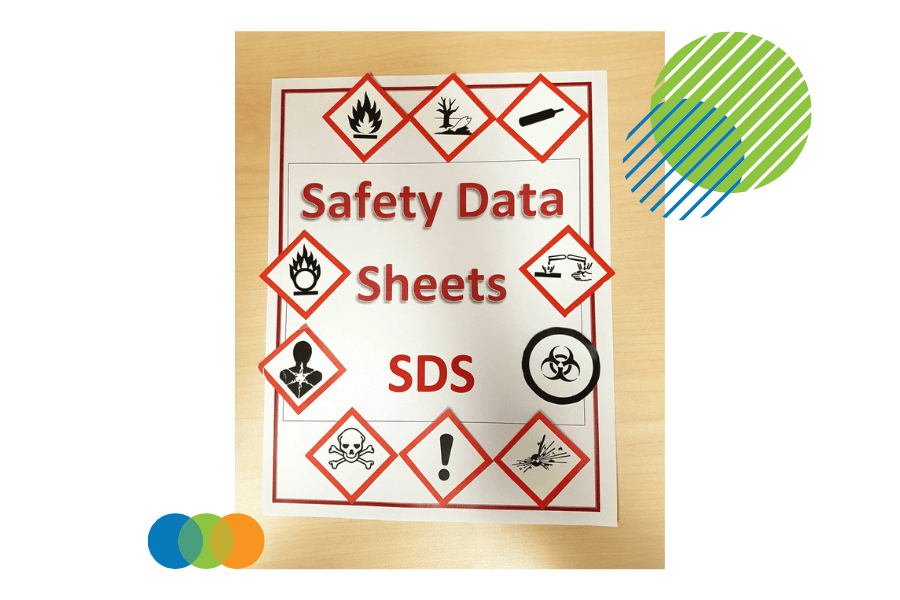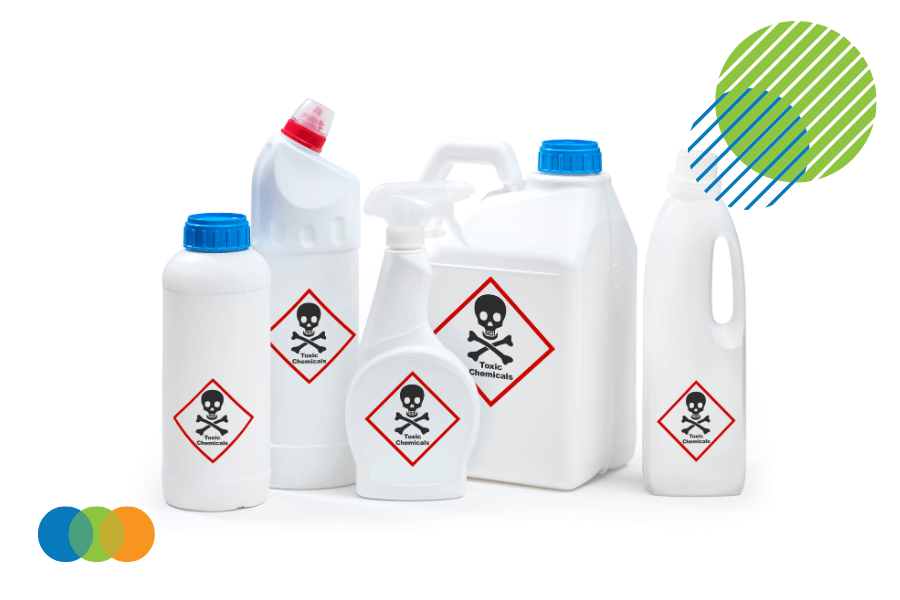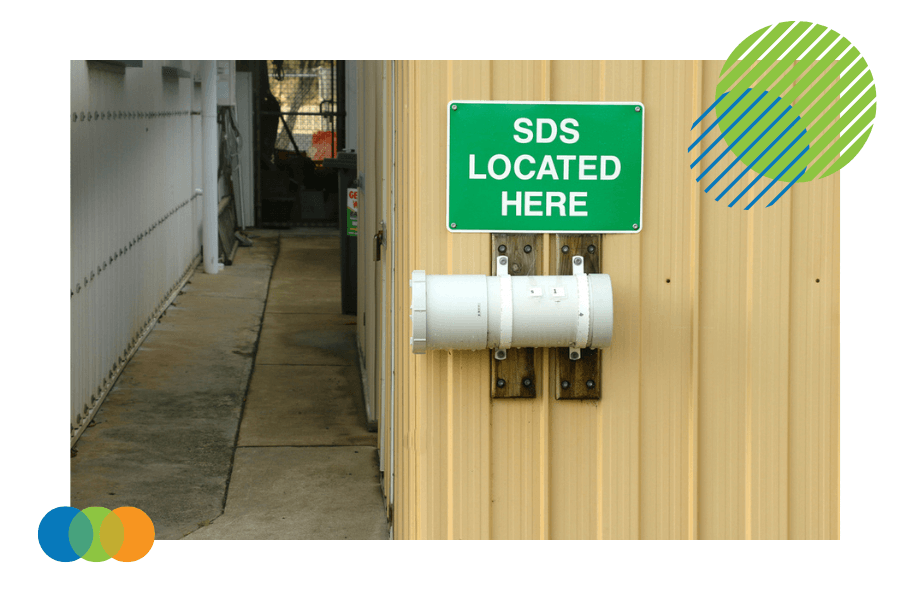 |
Written by Liz McDermott |

In the workplace, Safety Data Sheets (SDS) are essential documents that provide information on the safe handling, storage, and use of hazardous materials.
Let’s dive into the world of Safety Data Sheets and learn what they are, why they are important, and how to read and interpret them. We will also answer some frequently asked questions about SDS that every employer should know.

TABLE OF CONTENTS:
- What is a Safety Data Sheet?
- Why are Safety Data Sheets important?
- What are WHMIS and OSHA, and what are their roles in SDS?
- SDS Structure and Format: What information is included in an SDS?
- Understanding Hazard Communication and Symbols
- Properties of Hazardous Substances
- How To Read And Interpret SDS
- Misconceptions About Safety Data Sheets
- Are Safety Data Sheets Public?
- How Do You Obtain An SDS?
- Who Needs To Have Safety Data Sheets?
- SDS Information for Employers
- Hazards and Precautions Associated With Chemical Manufacturers

What is a Safety Data Sheet?
A Safety Data Sheet or material safety data sheet (SDS) is a document that provides information on the properties of chemicals and instructions for safe handling, use, and storage. SDSs are typically legally required in countries following the Globally Harmonized System (GHS) of Classification and Labelling of Chemicals created by the United Nations, including the United States and Canada, and must be provided by chemical manufacturers or importers. SDSs replaced Material Safety Data Sheets (MSDSs) in these regions and are part of the company's hazard communication standard.
The primary purpose of a Safety Data Sheet is to communicate protective measures to ensure the safe handling of hazardous substances, protecting individuals from harm and the environment from contamination. SDSs are vital for employers and employees to understand the risks associated with the dangerous chemicals they work with and the necessary precautions to take when handling them.
Why are Safety Data Sheets important?
Safety Data Sheets are important for several reasons. Firstly, they provide helpful information on chemicals' physical and chemical makeup, including their toxicity, reactivity to other elements, and flammability. This information is crucial for understanding the risks associated with a material and the necessary precautions to take when handling it.
Secondly, SDSs provide protective measures for safely handling, storing, and using dangerous materials. They include personal protective equipment (PPE) information, ventilation requirements, laboratory safety, and emergency procedures. By following the instructions in an SDS, employers and workers can reduce the risks of handling hazardous substances.
Finally, SDSs are required by law in many countries, including the United States and Canada, to ensure a hazard communication standard on the safe handling of hazardous substances in the workplace. Failure to comply with SDS requirements can result in fines and legal action.
What are WHMIS and OSHA, and what are their roles in SDS?
WHMIS (Workplace Hazardous Materials Information System) is a Canadian hazard information and communication system. At the same time, OSHA (Occupational Safety and Health Administration) is a United States agency responsible for workplace safety and occupational health. WHMIS and OSHA require SDSs for hazardous substances used in the workplace and have specific requirements for their content and format.
Check out our online courses for OSHA and WHMIS training compliance to improve your hazard communication and SDS knowledge.


SDS Structure and Format: What information is included in an SDS?
SDSs have a standardized format and structure to ensure consistency and ease of understanding. The following sections are included in an SDS:
- Section 1: Identification
This section includes the product name, manufacturer information, and emergency contact information. - Section 2: Hazard(s) identification
This section provides information on the risks associated with the material, including physical and health hazards. - Section 3: Composition/information on ingredients
This section lists the ingredients in the material and their concentration. - Section 4: First-aid measures
This section provides instructions for first-aid measures in the event of exposure to the material. - Section 5: Fire-fighting measures
This section provides information on the fire risks associated with the material and instructions for extinguishing fires. - Section 6: Accidental Release Measures
This section provides instructions for containing and cleaning up spills or releases of the material. - Section 7: Handling and storage
This section provides information on the safe handling and storage of the material, including PPE requirements. - Section 8: Exposure controls/personal protection
This section provides information on exposure limits and PPE requirements. - Section 9: Physical and chemical properties
This section provides information on the properties of the material. - Section 10: Stability and Reactivity
This section provides information on the stability and reactivity of the material. - Section 11: Toxicological information
This section provides information on the toxicology of the material, including acute and chronic effects. - Section 12: Ecological information
This section provides information on the environmental impact of the material. - Section 13: Disposal Considerations
This section provides instructions for the safe disposal of the material. - Section 14: Transport information
This section provides information on the transportation of the material. - Section 15: Regulatory information
This section provides information on the regulatory requirements associated with the material. - Section 16: Other information
This section provides any other relevant information not included in the previous sections.
Understanding Hazard Communication and Symbols
Hazard communication provides information on the risks associated with a substance and the necessary precautions for safe handling. Hazard communication is typically achieved through labeling, SDSs, and employee training.
SDS symbols are standardized pictograms that indicate the hazard associated with a material or chemical name. The most commonly recognized symbols are the diamond-shaped symbols used in the Globally Harmonized System (GHS) of Classification and Labelling of Chemicals. These symbols are used to indicate the following types of hazards:
- Physical Hazards (flame, explosion, corrosion, etc.)
- Health Hazards (acute toxicity, carcinogenicity, respiratory sensitizer, etc.)
- Environmental Hazards (aquatic toxicity, ozone depletion, etc.)
Understanding SDS symbols is essential for identifying the risks associated with a material and taking the necessary safety precautions when handling it.

Properties of Hazardous Substances
Physical and chemical properties are important for understanding the risks associated with a hazardous material. Some of the properties that are included in an SDS include:
- Appearance and odor
- Boiling point and melting point
- Vapor pressure
- Solubility
- Flash point
- Explosive limits
- pH
- Reactivity
Understanding these properties can help employers and employees identify the risks associated with a used substance, material, or substance and take the necessary precautions to prevent exposure or release.

How To Read And Interpret SDS
Reading and interpreting an SDS can be overwhelming, but there are a few key things to keep in mind:
- Start with the product name and manufacturer information to ensure you have the correct SDS.
- Look for the hazard classification and label elements to identify the type of hazard associated with the material.
- Read the first-aid measures, exposure controls/personal protection, and handling and storage sections to understand the precautions necessary for safe handling.
- Review the properties to understand the risks associated with the material.
- Look for any special precautions or emergency procedures that may be necessary.
- Pay attention to any regulatory information or transportation requirements.
Common Mistakes To Avoid When Reading SDS
There are a few common mistakes to note and avoid when reading SDSs:
- Assuming that all materials with the same name have the same risks and precautions
- Not paying attention to the concentration of ingredients
- Overlooking the properties of the material
- Not understanding the hazard symbols or label elements
- Not following the instructions provided in the SDS
Misconceptions About Safety Data Sheets
Several misconceptions about SDSs are essential to address:
- SDSs are only necessary for large companies:
SDSs are required for any employer who uses or handles dangerous materials, regardless of their size. - SDSs are only necessary for highly toxic materials:
SDSs are required for any material that meets the criteria for a hazardous material, which includes a wide range of materials with varying toxicity levels. - SDSs are only necessary for materials that are used in large quantities:
SDSs are required for any material that meets the criteria for hazardous material, regardless of the quantity used.
Employers and employees must understand the requirements for SDSs and ensure chemical safety in compliance with the law.
Are Safety Data Sheets Public?
SDSs are typically not considered public documents and are only provided to individuals who need to know the information or chemical substance they contain. However, in some cases, SDSs may be accessible to the public through government agencies or chemical manufacturers.
How Do You Obtain An SDS?
SDSs are typically provided by chemical manufacturers or importers, and paper copies should be made available to employers who purchase or use their products. If you need an SDS for a product you have purchased or received, you should contact the manufacturer or supplier to request a copy.

Who Needs To Have Safety Data Sheets?
Employers with personnel who use or handle dangerous materials must have SDSs available for their employees. Employers must also ensure that their workers are trained on the risks associated with the materials they work with and the precautions necessary to prevent exposure or release of chemical hazards.
SDS Information for Employers
Employers have several responsibilities when it comes to access to SDSs, including:
- Ensuring that SDSs are available for all hazardous substances used in the workplace
- Ensuring that employees are trained on the hazards associated with the materials they work with and the necessary precautions to take
- Keeping SDSs on file for at least 30 years
- Ensuring that SDSs are regularly updated and reviewed for accuracy
How Long Must SDS Be Kept On File For?
SDSs must be kept on file for at least 30 years after the last use of the material. This ensures the information is available for future reference and in case of legal action.
Storing SDS Electronically: "What happens when the power goes out?"
SDSs can be stored electronically as long as they are readily accessible to workers. However, employers should have a plan for accessing SDSs during a power outage or other technical access issues, such as keeping SDS binders.

Hazards and Precautions Associated With Chemical Manufacturers
Chemical manufacturers and suppliers have several responsibilities when it comes to SDSs, including:
- Providing accurate and complete information in the SDS
- Ensuring that the SDS is updated and reviewed regularly
- Providing training and support to employers and employees who use their products
- Complying with all regulatory requirements for SDSs
In Summary: Tips For Creating And Maintaining SDS
SDSs are essential for chemical safety, ensuring the safe handling, storage, and use of hazardous chemicals and materials in the workplace. To create and maintain effective SDSs, employers and chemical manufacturers should:
- Ensure that all necessary information is included in the SDS
- Use a standardized format and structure to ensure consistency and ease of understanding
- Regularly review and update SDSs for accuracy
- Provide training and support to employees on the hazards associated with the materials they work with
- Comply with all regulatory requirements for SDSs
By following these tips, employers and chemical manufacturers can ensure that their SDSs are practical tools for protecting individuals and the environment from harm.
For more information, please contact us to inquire about our safety training programs.
